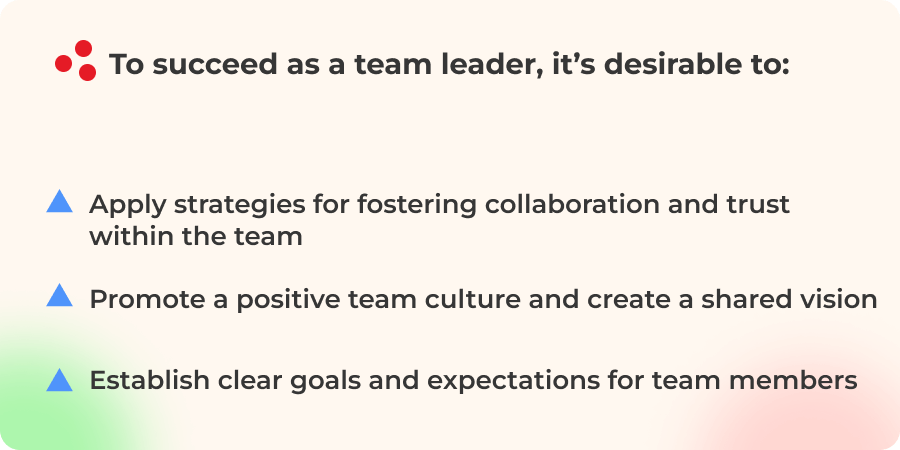Team Lead: What Do They Do and Which Skills Should They Have?

The performance of any team largely depends on the talents and skills of its leader. When staff members trust their leaders, they are more eager to pursue their employer’s goal and less prone to leaving the organization. Research shows that companies that purposefully train their leaders on all levels tend to be over 4 times more efficient than those that target such training only to managers. Nearly one-half of all businesses suspect they might face a deficit of leadership skills.
In this article, we’ll address two questions: “What is a team lead?” and “What does a team leader do?”. We’ll clarify which skills this professional should develop and which principles they should rely on. Plus, we’ll draw your attention to the delicate balance between managing people and tasks.
Definition of a Team Leader
Let’s start with a team lead meaning. In the narrowest sense of the term, it’s a professional who supervises a team. However, their scope of responsibilities goes beyond being a manager. A manager makes sure all the tasks are completed on time and the result is of high quality. A teamleader takes care not only of the to-dos and processes – but also of the people.
The leader makes sure each member makes the most of their skills and talents. They strive to make collaboration exciting and fruitful for everyone. They do their best to boost the job satisfaction of every specialist involved and inspire them. It’s a scientifically proven fact that happy teams perform better and allow their employers to earn more money.
Here is the list of what a team lead needs to do:
- Oversee the team’s activities, providing guidance and instructions. This range of duties is similar to what a manager does.
- Organize the workflows, compose schedules and structure tasks. If the team relies on task management software, the lead analyzes the accumulated statistics and makes data-driven decisions based on it.
- Think strategically about how to approach tasks and projects. Three goals need to be achieved: make the client happy, bring a profit to the employer, and let each team member shine in exchange for remuneration.
- Set goals for the team as a whole and each of its members individually. Here are common examples of goals: adopt an advanced time management technique or minimize distractions by 10%.
- Clarify the roles of each team member. It’s especially important if the roles overlap or the team needs to handle an unusual type of task.
- Distribute information among team members and any third parties involved, such as stakeholders. The lead makes sure everyone gets the same version of the document and familiarizes themselves with it on time.
- Organize team meetings and discussions to make sure everyone remains on the same page. An experienced lead knows how to structure and present the information. They prevent the meetings from becoming too long – and manage to discuss everything within a relatively short time frame.
- Coach team members to facilitate their development and enable them to achieve the desired results. Some specialists need more intense coaching than others. The lead should develop an individual approach to everyone.
- Strengthen the team by adding new members to it, delegating tasks, and detecting areas for improvement. While doing so, it’s essential to remain polite and tolerant.
- Monitor the team’s progress by identifying the notion of success and measuring the process of moving toward it. As soon as the notion or goals change, it’s crucial to inform everyone about it.
- Prevent conflicts by clearly outlining the terms of collaboration – and solve them if they arise. A good lead doesn’t let conflicts escalate and is ready to listen to all the sides involved.
Now that you understand the designation of a team lead, let’s switch to the skills necessary for this role.
Vital Skills of a Team Leader
A professional who wants to occupy the team leader role should develop the set of skills that includes:
- Effective communication and interpersonal skills. The lead is regularly involved in conversations with their team members as well as other employees of the organization and maybe also clients. They should be equally good at oral and written communication, either face-to-face and within a group.
- Decision-making, problem-solving, and conflict-resolution abilities. The decisions that the leader makes affect the whole team. It’s important to align them with the goals and policies of the organization. Conflicts are inevitable in any collective – and the leader should know how to prevent and solve them.
- Motivational and coaching skills to inspire and develop team members. All employees appreciate motivation and deserve praise. It would be wrong to believe that only newcomers and the least efficient employees need support.
- Adaptability and resilience in managing diverse team dynamics. It might take years to form a tight-knit team whose all members perform equally well and perfectly understand each other. The leader should be able to acknowledge challenges as they pop up and find ways to tackle them.
Team leads can differ considerably in their personalities and their impact on the collectives. For instance, Richard Branson, the founder of Virgin Group, is renowned for his boldness and innovation. Mary Barra, the CEO of General Motors, puts an emphasis on transparency and effective communication. Satya Nadella, the CEO of Microsoft, deserves praise for her empathy and the focus on employee well-being. Everyone should detect and develop their strongest sides to genuinely shine.
Primary Principles of Successful Team Leadership

Below, we’ll have a closer look at each of these points separately.
Strategies for Fostering Collaboration and Trust within the Team
To promote cooperation and mutual trust within a group, its leader should:
- Foster honesty. Sometimes, people hesitate to complain or ask for help. They are afraid that others will laugh at them, gossip about them, or start a confrontation. An experienced team lead respects everyone, even if a person has an unusual opinion. They listen attentively to each member and know how to keep secrets.
- Support collaboration. From time to time, most professionals have to deal with tasks that aren’t a part of their everyday range. The team lead encourages everyone to gain new skills and leave their comfort zone for a while. They distribute non-standard tasks among the group in the most rational manner. In the long run, such an approach can facilitate both vertical and horizontal professional development of staff members.
- Allow self-organization. Top team leads avoid micromanagement. They provide employees with guidelines and set goals for them. However, staff members remain to a large extent autonomous in their hands-on activities. They should be allowed to interact among themselves freely. When specialists self-organize, they feel more fulfilled and begin to trust each other more.
- Provide feedback. People need it to feel confident in their roles. They want to know whether they acted wrong or right. Ideally, the leader should provide feedback as promptly as possible. If there are errors to fix, the lead should address the issue politely and with a positive attitude. It’s important to provide suggestions for improvement and share illustrative examples. If there is nothing to criticize, the specialist will be glad to hear the lead praise them.
Besides, it’s crucial to clarify roles and responsibilities within the team. We could have added this point to the list above. Instead, we prefer to discuss it in detail in one of the next passages.
Promoting a Positive Team Culture and Creating a Shared Vision
The concept of a positive team culture means that all team members trust each other and work in a mutually supportive environment. They are exposed to stress as little as possible. If they fail to understand something or can’t cope with a task, they can always ask for help – and there won’t be any negative reactions to it. In a nutshell, employees should feel at home at work. And their leader is in charge of creating and maintaining such conditions.
As for the shared vision, it means that all the members of the collective should share identical goals and values. It’s vital to verbalize and/or visualize them and distribute them among the employees. Project management apps can come in handy for this purpose. They comprehensively display the progress of the project – and each person involved can see their contribution.
Establishing Clear Goals and Expectations for Team Members
Before they join the team, each new member should get answers to the following questions:
- What are our common goals and how will I contribute to achieving them?
- What are the tasks and responsibilities of each member?
- What are the rules for communication and cooperation within the team?
If a person knows from the onset what to expect, they will be more likely to perform better and the risks of conflicts will decrease. They will avoid overexertion and will concentrate their efforts on genuinely meaningful tasks.
It’s up to the team lead to set goals and clarify their essence for everyone. The goals should be realistic and the progress toward them should be unambiguously measurable. Sometimes, the team gets down to work and realizes that some goals might take more time and resources than initially planned. Then, the lead should adjust the goals.
Balancing Task Management and People Leadership

A team lead needs to strike a delicate balance between managing tasks and people. In this relation, we’d like to outline two especially important aspects.
Managing Team Priorities While Supporting Individual Growth and Development
A team is not a monolithic construction. It consists of people, each of which has its distinct character, experience, objectives, and life circumstances. If a person feels that they stagnate in their current position, their performance might decrease. Eventually, they might feel the urge to quit. To prevent it, the team leader should foster each member’s professional and personal development.
Let’s imagine that a team member lacks the confidence to tackle a specific type of task. The leader should discuss it with them in a friendly and reassuring manner. Maybe, the specialist lacks selected skills and doesn’t know how to acquire them. In this case, the leader should inform the team member about the possible learning opportunities and maybe organize them for them. Another potential reason is that the professional tried to cope with such tasks in the past and failed. Then, the leader can accompany the staff member at each stage of completing the task to ensure their success. The leader can provide guidance to the specialist before each stage and deliver feedback at the end of the stage. And of course, it’s crucial to grant psychological support to help the person overcome their fears.
Aligning Team Objectives with Organizational Goals and Strategies
A team doesn’t function by itself in an isolated space. It’s a part of a larger organization and needs to obey the latter’s rules and standards. However, the requirements might differ from one team to another.
Let’s imagine a financial company that consists of multiple departments. One of the departments deals with high-net-worth clients. For security reasons, the employees work from the office and not remotely. They avoid compromising sensitive data by sending or discussing it online. They meet their clients in person in a dedicated room. This team is one of the most conservative within the company. Its members need to boost two sets of skills, related respectively to finance and communication.
At the same time, there is an in-house creative department in the organization. It consists of managers, designers, editors, advertisers, and SMM specialists. They, in turn, commission visuals, texts, and other products to freelancers scattered around the world. The members of this team are allowed to work in a remote or hybrid format. They don’t have to meet the clients. Their workflows and standards are more flexible.
Both teams pursue the same goal – enable their employer to make a steadily high profit, deliver services of the highest quality, and outperform its competitors. However, they approach their duties differently, according to the specifics of their everyday tasks. Their leaders are not interchangeable. If the leader of the former team needs to head the latter team, they will have to undergo training – and vice versa.
Conclusion
Hopefully, this text gave you a comprehensive answer to the question “What is the role of a team leader?”. This professional is indispensable for the team’s success. They oversee the workflows of the collective, set goals for it, coach its members, distribute information among them, and resolve conflicts. They make sure all the members work toward a common goal, clearly define this goal for them, and monitor the progress of achieving it.
Feel free to apply the principles from our article to excel in the team leader position! This knowledge is relevant for nearly any industry and company size.



